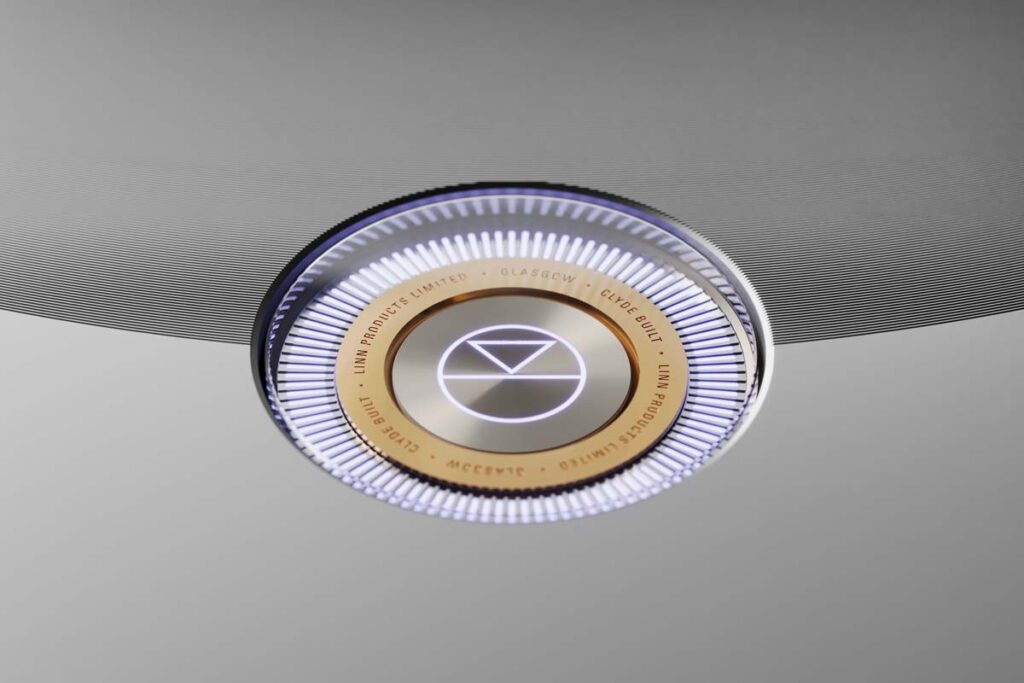“The conventional lends the world its existence. The unusual gives it its value”
Oscar Wilde
It may seem odd to quote a famous Irish poet when introducing the most powerful power amplifier yet built by Scottish manufacturer Linn. But exclusive components call for extraordinary words. Moreover, given its price, the Linn Klimax Solo 800 is anything but conventional.
This exclusivity is also why we didn’t get to sound out the über-device either at home or in the FIDELITY offices. At the time of writing, only three of the €89,260 pairs of Klimax Solo 800s were available from dealers in Germany. Understandably, they were reluctant to lend these out for an extended time period. That’s why editor-in-chief Carsten Barnbeck and I made the trip to Hifi Bamberg in Hirschaid (Upper Franconia). The owner, Christian Müller, kindly agreed to open his store to us for an afternoon so that we could conduct our research for this article.
Once there, I fell in love with the Linns at first sight. The design of these juggernauts was so breathtaking that they won me over before I even heard a single note. Well and beyond similar products from other manufacturers, I would describe the look of the Klimax Solo 800 as “hypermodern”. Linn upholds minimalism with all its products and deliberately dispenses with any switches or controls visible from the front – they would only mar the elegance. The silver front (a black version is also available) is broken up by just a circular section dividing the smooth area into two parts with different surface finishes, creating a tasteful contrast. The dominant design feature of its natural playing partner Linn Klimax DSM/3 – Linn’s top of the range streaming preamplifier – is found here as well. We find the same data wheel rotary dial known from the DSM/3. However, in the Solo 800 it is purely a display – nothing to be switched or controlled here. The ring of 100 LEDs indicates the operating status and present a light show at start-up or when switching to standby mode. Meanwhile, the main switch is discreetly concealed on the right under the front – so that it doesn’t detract from the design, all while remaining easy to reach.
The clearly structured rear panel has an unusually large number of connections. There are inputs and outputs, both single-ended RCA and balanced XLR sockets. A push-button switch toggles between them. The outputs can control additional power amplifiers or active subwoofers. A three-stage slider controls the display brightness. The solid speaker terminals accept speaker cables terminated with banana plugs or spades. As expected, it’s not just the build quality of the connections that is beyond reproach. The graceful curves of the heat sinks are also remarkable. This, in combination with the internal architecture of the Solo 800, has removed the need for any fans, which are often found on comparably powerful amplifiers.
Linn would not be Linn if its latest creation didn’t also use a particularly powerful version of the well-known Utopik switching power supply. According to the manufacturer, this should be good for a stable 2000 watts without distortion. At the speaker terminals, 800 watts are available at four ohms and 400 watts at eight ohms. At two ohms it can even deliver a massive 1200 watts. Based on these figures, it should be quite difficult to find loudspeakers that the Klimax Solo 800 can’t handle.
But power isn’t everything, and so special attention has been given to the bias current control. In conventionally constructed amplifiers, this is typically set by hand at the factory. However, as these values can change over time and depending on the temperature, they must actually be recalibrated at regular intervals. Linn relies on automated control here. A digital control circuit monitors the current flow of the sixteen power transistors and adjusts the bias current in real-time as necessary. This method is called “Adaptive Bias Control” and is intended to reduce crossover distortion to ensure that the transistors are in continuously optimum conditions over their entire service life and at any temperature.
Oscar Wilde would likely appreciate the elegance, but would at best be sympathetic to the ultra-modern yet, in his view, “profane” technology. However, music reproduction through the Linn Klimax Solo 800 would undoubtedly delight him and other connoisseurs. This becomes unmistakably clear when listening to Carl Maria von Weber’s Oberon Overture (Decca SXL 6830). It begins with a quiet, delicate intro, where you can truly get comfortable in your listening chair, only to be startled by an explosive tutti beat. The Solo 800 is certainly not the kind of power amplifier that can barely move for all its muscle. This speed very likely is born of the Utopik power supply unit’s performance. The fact that the imaging – the localization of individual instruments as phantom sound sources – is maintained without any blurring, even in the most intense fortissimo passages, can probably be taken for granted in this performance class. What is not so self-evident, however, is the maintenance of the rhythmic flow. Carsten Barnbeck, sitting beside me, recognized this as well, as he found himself involuntarily tapping his toes to the beat of the music – and we’re talking classical here!
I’ve often sat in front of high-quality systems that formally got “everything right”, but for some unknown reason the emotions you expect to be generated fall by the wayside. This is precisely not the case with the Linn Klimax Solo 800. The rendition of Johnny Cash’s ballad “Give My Love To Rose” (American IV: The Man Comes Around) – in which a first-person narrator finds a dying man who asks him to send his regards and money to his wife and son, whom he hadn’t seen in a long time – gave me goose bumps. Cash’s fragile voice and the guitars that accompany him are so vivid that it was as if the musicians were sitting right in front of me. A humdinger of a presentation!
Lest you think I exaggerate my enthusiasm, I must point out that the sound description applies to the hi-fi system as a whole (see accompanying equipment). Fortunately, I was very familiar with the DS Audio cartridge and Magico speakers in particular from previous encounters. With this in mind, I believe I can justifiably claim that the Linn Klimax Solo 800 made a decisive contribution to the sound impression. In any case, I can fully confirm Linn’s own claim to have created an amplifier that is capable of driving any loudspeaker perfectly – regardless of the conditions.
To conclude, I’ll take the liberty of quoting Oscar Wilde once more: “I have the simplest tastes. I am always satisfied with the best.” If you are among the lucky who can afford to live by this maxim, then congratulations on investing in the Linn Klimax Solo 800. For everyone else, we can only hope that Linn transfers the experience gained from developing this state-of-the-art product and design to the company’s more affordable power amplifiers without compromising sound quality. It would not be the first time that the Scots have succeeded in doing so.
Accompanying Equipment
Turntable: Reed Muse 1C | Tonearm: Reed 5A | Cartridge: DS Audio DS-W3 | Streamer/Preamplifier: Linn Klimax DSM/3 | Loudspeakers: Magico S3 | Cables: WestminsterLab Ultra
Power amplifier Linn Klimax Solo 800
Concept: Transistor power amplifier with Class A/B circuitry | Special features: Ground connection, Adaptive Bias Control, Utopik switching power supply | Inputs: RCA (single-ended), XLR (balanced) | Outputs: RCA (single-ended), XLR (balanced), 5-way binding posts (loudspeaker) | Finish: Silver or black | Dimensions (W/D/H): 35/41/27 cm | Weight: 27 kg | Warranty period: 5 years | Price: around 44 630 €/unit
Linn Products Ltd.













